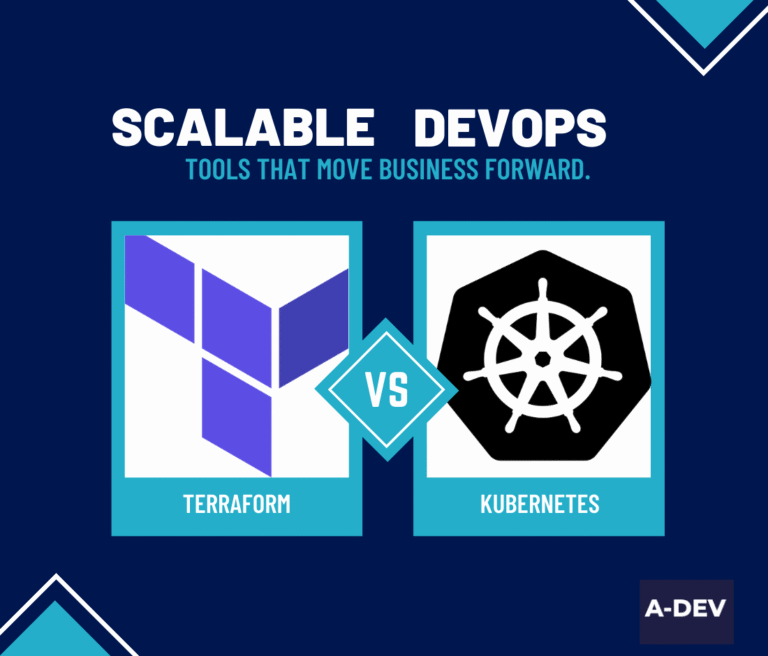
In today’s fast-paced software development landscape, delivering high-quality software quickly and efficiently is paramount. However, traditional approaches often struggle to keep up, leading to silos between development and operations, slow release cycles, and quality issues. Fortunately, DevOps strategy offers a powerful solution. This guide serves as your DevOps implementation roadmap, equipping software development teams with the key steps, the secret ingredient for success, and the value proposition of embracing DevOps. Get ready to unlock faster releases, improved software quality, and increased agility for your development team and your entire organization.
Breaking Down Barriers: Building a Collaborative Environment

DevOps strategy thrives on a shared responsibility between development (Dev) and operations (Ops) teams. This cultural shift requires breaking down silos and fostering a collaborative environment where both teams work seamlessly towards common goals. Here’s how to achieve this:
1. Open Communication and Information Sharing:
- Dedicated channels: Establish dedicated communication channels, such as team chats, collaborative platforms, and regular meetings, to facilitate transparent and ongoing exchange of information. This creates a sense of trust and allows for early problem identification and resolution.
- Active listening: Encourage active listening during meetings and discussions, ensuring everyone feels heard and understood. This fosters a more inclusive environment and allows for diverse perspectives to be considered.
- Knowledge sharing: Implement knowledge-sharing initiatives like brown bag lunches, code reviews, and internal document repositories. This allows both teams to learn from each other’s expertise and fosters a sense of collective learning and growth.
2. Shared Goals and Objectives:

- Align team goals: Align development and operations teams with common objectives that extend beyond individual team goals. These objectives could involve metrics such as:
- Faster release cycles: Focus on reducing the time it takes to deliver new features and updates to users.
- Improved software quality: Emphasize the importance of delivering high-quality software with fewer bugs and defects.
- Increased customer satisfaction: Prioritize delivering software that meets and exceeds customer expectations.
- Shared ownership: Promote a culture of shared ownership where both teams feel responsible for the entire software development process, from conception to deployment and ongoing maintenance.
3. Empowerment and Ownership:

- Decision-making authority: Empower both teams to make informed decisions within their areas of expertise. This fosters a sense of agency and ownership, leading to increased engagement and motivation.
- Recognition and rewards: Implement recognition and reward systems that acknowledge and celebrate collaborative efforts and achievements. This reinforces the importance of collaboration and motivates teams to work together effectively.
- Continuous learning and development: Encourage and support continuous learning and development opportunities for both teams. This allows individuals to acquire new skills and knowledge, enhancing their ability to collaborate effectively in a DevOps environment.
Remember: Leadership buy-in and commitment are crucial for successful implementation. By actively promoting collaboration, providing resources, and leading by example, leaders can create a supportive environment where DevOps strategy can flourish.
By implementing these strategies, you can break down barriers, build a collaborative environment, and lay the foundation for a successful DevOps implementation.
Bolstering Your DevOps Journey: The Value of DevOps Specialists
While a strong collaborative culture is essential, consider bolstering your DevOps implementation journey by incorporating DevOps engineers into your team. These individuals possess a unique skillset, bridging the gap between development and operations, and offering significant value:
1. Expertise in DevOps Practices and Tools:

Comprehensive Toolchain Selection and Implementation:
DevOps engineers possess deep knowledge of a wide range of DevOps tools and technologies, enabling them to:
- Guide selection and implementation: They can assist you in identifying, evaluating, and implementing the most suitable CI/CD and continuous delivery pipelines with continuous deployment capabilities, configuration management tools, monitoring tools, and infrastructure as code (IaC) solutions, all tailored to your specific needs and environment.
- Optimize workflows and processes: By leveraging their expertise in DevOps best practices, they can analyze your existing workflows and pinpoint areas for automation and optimization, leading to a streamlined software development lifecycle.
This comprehensive approach ensures that your DevOps toolchain seamlessly integrates with your existing infrastructure and development processes, driving efficiency and agility.
2. Championing Cultural Change:
- A DevOps team can act as champions for cultural change, actively promoting collaboration, shared responsibility, and a DevOps mindset throughout your organization. By facilitating workshops, leading discussions, and breaking down existing silos between development and operations, they play a crucial role in to implement DevOps methodology effectively.
- Bridge the communication gap: With their understanding of both development and operations perspectives, they can effectively bridge the communication gap between teams, ensuring clear and transparent communication throughout the development lifecycle.
3. Streamlining Workflows and Automating Tasks:

- Identify areas for automation: DevOps team possess a keen eye for identifying repetitive tasks and manual processes that can be automated using appropriate tools and technologies. This can significantly improve efficiency and reduce the time spent on tedious manual work.
- Implement efficient processes: They can actively design and implement efficient processes that are aligned with DevOps implementation strategy and best practices, ensuring smoother workflows and faster delivery cycles.
By incorporating DevOps specialists, you can bolster your DevOps implementation process by leveraging their expertise, fostering cultural change, and streamlining workflows for increased efficiency and speed.
The Cornerstones of Success: Core DevOps Principles in Action
When implemented effectively, the following core principles contribute significantly to a successful DevOps journey:

1. Continuous Integration (CI):
This principle automates the process of merging code changes from developers into a central repository. It also triggers automated testing and feedback loops, ensuring early identification and resolution of potential issues.
2. Continuous Delivery (CD):
CD automates the deployment process, allowing for frequent and reliable software releases. This reduces the risk of introducing defects in production and enables faster delivery of new features and updates to users.
3. Continuous Deployment (CD):
This builds upon CI/CD by automatically deploying all code changes that pass the pipeline directly to production. This practice streamlines the delivery process, leading to faster feedback loops and increased agility. However, it requires robust testing and a high level of confidence in the automated processes due to the potential impact of deploying unreviewed changes.
4. Infrastructure as Code (IaC):
IaC treats infrastructure as code, enabling consistent and automated provisioning and management of infrastructure resources. This ensures consistency, reduces human error, and streamlines infrastructure management.
5. Monitoring and Feedback:
Continuous monitoring of the performance and health of your systems and applications is crucial. Utilizing the gathered feedback allows you to identify areas for improvement and iterate on your processes, ensuring ongoing optimization and efficiency.
By adhering to these core principles and fostering a collaborative environment, you can empower your teams and unlock the full potential of DevOps, leading to faster delivery, improved software quality, and increased agility.
DevOps Implementation Plan: Charting Your Course to Success

To translate the theoretical principles of DevOps into practical action, a well-defined DevOps implementation plan is crucial. This plan serves as a roadmap, guiding your organization’s journey towards a more efficient, collaborative, and high-performing software development process.
Developing a Comprehensive Plan:
Here are the key steps involved in crafting a successful DevOps implementation plan:
Assess Your Current State:
Conduct a thorough analysis of your existing software development processes. Identify bottlenecks, inefficiencies, and areas where principles of DevOps can create the most significant impact. This assessment provides a baseline understanding of your starting point and informs your overall plan.
Define Goals and Objectives:
Establish clear, measurable, and achievable goals for your DevOps implementation. These goals should align with your overarching business objectives and address the specific challenges identified in the assessment phase.
Develop a Strategy:
Carefully choose the tools, technologies, and approaches that best suit your specific needs and resources. Consider factors like team size, budget, existing infrastructure, and the complexity of your development process when making these selections.
Outline a Timeline:
Create a realistic timeline for implementing your DevOps plan, breaking down the process into manageable phases with clear milestones. This timeline should be achievable yet ambitious, keeping your team motivated and focused on progress.
Identify Resources:
Determine the resources required to execute your plan effectively. This includes personnel with the necessary skills and expertise, budget allocation for tools and training, and any additional resources needed to support the implementation process.
Establish Communication Plan:
Define a clear communication plan to keep all stakeholders informed of the progress, challenges, and successes throughout the DevOps implementation journey. This fosters transparency, alignment, and buy-in from all involved parties.
Infrastructure Automation Tools: Streamlining Infrastructure Management
A critical aspect of a successful DevOps implementation is the adoption of infrastructure automation tools. These tools enable teams to automate the provisioning, configuration, and management of infrastructure resources, leading to:
Increased efficiency and agility:
Automating repetitive tasks frees up valuable time and resources, allowing teams to focus on higher-level activities like development and innovation.
Improved consistency and reliability:
IaC (Infrastructure as Code) ensures infrastructure is defined and managed consistently across different environments, minimizing the risk of errors and configuration drift.
Reduced costs:
Automating infrastructure management can help optimize resource utilization and reduce the need for manual intervention, leading to cost savings.
Here are some examples of popular automation tools:
Terraform:
A widely used open-source tool that supports a wide range of cloud providers and on-premises infrastructure. It allows you to define infrastructure as code using a human-readable configuration language.
Read our article to better understand which tool to choose and what are the differences between them Terraform vs Kubernetes: A Practical Guide to Choosing the Right Tool
Ansible:
Another open-source tool that uses a simple and agentless architecture to automate infrastructure provisioning and configuration. It leverages playbooks, which are reusable workflows, to automate complex tasks.
AWS CloudFormation:
A managed service offered by Amazon Web Services that allows you to define and provision infrastructure resources using templates written in JSON or YAML format.
Azure Resource Manager (ARM):
A similar service offered by Microsoft Azure that provides a unified way to manage and deploy resources across your Azure subscription.
The choice of tools mentioned above depends on various factors, such as your specific needs, budget, and existing infrastructure. It’s crucial to carefully evaluate your options and select a tool that best aligns with your requirements and technical expertise.
By incorporating right tools into your DevOps implementation plan, you can streamline infrastructure management, improve efficiency and consistency, and ultimately empower your teams to focus on delivering high-quality software faster.
Unlocking the “Why” and “How”: Deeper Insights into DevOps Implementation

Embarking on your DevOps journey requires not only understanding the “what” but also diving deeper into the “why” and “how.” This section delves into the practical steps, compelling benefits, and value proposition of implementing DevOps for software development teams.
1. DevOps Implementation: Where to Start?
Taking the first step towards DevOps can seem daunting. However, by following these initial steps, you can set yourself up for success:
- Assess your current state: Analyze your existing software development processes. Identify bottlenecks, inefficiencies, and areas for improvement. This initial assessment will guide your DevOps roadmap and highlight areas where principles of DevOps can create the most significant impact.
- Set achievable goals: Start with small, achievable goals that can be accomplished within a specific timeframe. This fosters a sense of accomplishment and motivates teams as they progress on their DevOps journey. As your team gains experience and confidence, you can gradually set more ambitious goals.
- Build a cross-functional team: Assemble a team with representatives from development, operations, and other relevant departments. This ensures diverse perspectives and fosters a collaborative environment where teams can work together effectively.
- Identify quick wins: Focus on areas where automating tasks and implementing DevOps strategy can yield immediate benefits. This can help build momentum and demonstrate the value of DevOps to stakeholders.
2. Why DevOps Strategy Is a Must?
DevOps is not merely a set of tools and practices; it’s a cultural shift that unlocks significant benefits for businesses and software development teams:
- Increased agility: Respond quickly to market changes and customer needs with faster release cycles. DevOps enables frequent and reliable deployments, allowing you to adapt and iterate more rapidly.
- Improved software quality: Continuous integration and continuous delivery (CI/CD) practices lead to early and frequent testing, resulting in fewer bugs and higher-quality software releases.
- Reduced costs: Automation and streamlined processes minimize manual work, leading to cost savings in terms of time, resources, and potential errors.
- Enhanced collaboration and communication: A collaborative environment fosters better communication and information sharing between development and operations teams, leading to improved problem-solving and decision-making.
- Increased innovation: DevOps fosters a culture of continuous improvement and experimentation, encouraging teams to explore new technologies and solutions, ultimately leading to increased innovation.
3. How DevOps Principles Bring Value?
Understanding how specific DevOps tools contribute to value for software development teams is crucial:
- Continuous integration (CI): By automating code merging and testing, CI enables earlier defect detection and resolution, reducing the time spent fixing bugs later in the development cycle.
- Continuous delivery (CD): Automated deployments through CD lead to faster release cycles, allowing teams to deliver new features and updates to users more frequently. This improves user satisfaction and keeps them engaged with the product.
- Infrastructure as code (IaC): IaC ensures consistency and repeatability in infrastructure provisioning and management, minimizing human error and allowing teams to focus on higher-level tasks.
- Monitoring and feedback: Continuous monitoring provides valuable insights into system performance and health, enabling teams to identify and address issues proactively. This feedback loop also helps teams improve processes and optimize performance over time.
By understanding the “why” and “how” of DevOps, software development teams can implement DevOps, embarking on a successful journey that unlocks its immense potential, leading to increased efficiency, agility, and innovation.
Tailoring DevOps Implementation to Startups: Addressing Specific Challenges and Unlocking Value

Building upon our previous discussion of DevOps implementation, let’s now tailor the approach specifically for startups. Startups face unique challenges and opportunities when it comes to DevOps, and understanding these nuances is crucial for a successful journey.
Startup-Specific Challenges
- Limited resources: Startups often operate with smaller teams and tighter budgets, requiring them to be resourceful and choose tools and approaches that are cost-effective and scalable.
- Rapid iteration: The fast-paced environment of startups necessitates rapid development and deployment cycles. DevOps practices and tools can significantly accelerate this process.
- Evolving culture: Fostering a DevOps culture can be challenging in a startup environment with frequent changes and a diverse team.
Overcoming Challenges and Unlocking Value

Here are some key strategies to consider:
- Start small and scale progressively: Begin by implementing DevOps practices in small, achievable steps. As the team gains experience and benefits are realized, you can gradually scale your approach.
- Leverage open-source tools: Many powerful and free open-source tools are available for automation, testing, and infrastructure management. These can be valuable resources for startups with limited budgets.
- Focus on automation: Automate repetitive tasks to free up valuable team time for innovation and strategic work.
- Promote collaboration and communication: Foster a culture of open communication and shared responsibility between development and operations teams from the outset. Encourage knowledge sharing and cross-team collaboration.
- Embrace continuous learning: Encourage continuous learning and development opportunities for your team members. This ensures they stay up-to-date with the latest DevOps trends and best practices.
Benefits of DevOps for Startups
By embracing a tailored DevOps approach, startups can unlock significant benefits:
- Faster release cycles: Deliver new features and updates to users more frequently, allowing for rapid iteration and feedback loops.
- Improved software quality: Continuous integration and delivery practices lead to early and frequent testing, resulting in fewer bugs and higher-quality software.
- Increased agility: Respond quickly to market changes and customer needs with greater flexibility and adaptability.
- Reduced costs: Automation and streamlined processes can save time and resources, leading to cost reductions.
- Enhanced team morale: Collaboration and a shared sense of ownership can foster a more positive and productive work environment.
Implementing DevOps addresses the unique challenges and opportunities faced by startups empowers them to unlock the full potential of this approach, ultimately gaining a competitive edge in the fast-paced startup landscape.
Conclusion
By embracing a collaborative DevOps culture, potentially incorporating DevOps specialists, and actively implementing DevOps practices, your software development team can unlock the full potential of DevOps. This translates to increased agility, improved software quality, reduced costs, and ultimately, a competitive edge in the market.
Remember: A-Dev is your trusted partner in navigating your DevOps implementation process. We provide the expertise, tools, and support you need to successfully implement DevOps. Contact us today to discuss your specific needs and embark on your successful DevOps journey.






